Abstract
A cell line (SMKT-R3) established from human renal cell carcinoma was characterized for the presence of sulfolipids and glycolipid sulfotransferases. Sulfolipids were found to constitute a large part of the acidic glycolipid fraction in SMKT-R3 cells. These findings were confirmed by metabolic labelling with 35S-sulfate. These sulfolipids were expressed at the surface of SMKT-R3 cells as ascertained by cytofluorometry using a monoclonal antibody directed to sulfolipids. Furthermore, markedly high activity levels of glycolipid sulfotransferases were observed in SMKT-R3 cells compared with other cell lines. These results suggest that the increased synthesis of sulfolipids in renal cell carcinoma tissue (Sakakibara et al., 1989. Cancer Res., 49, 335-339) is due to the elevation of the sulfotransferase activities of renal carcinoma cells themselves.
Full text
PDF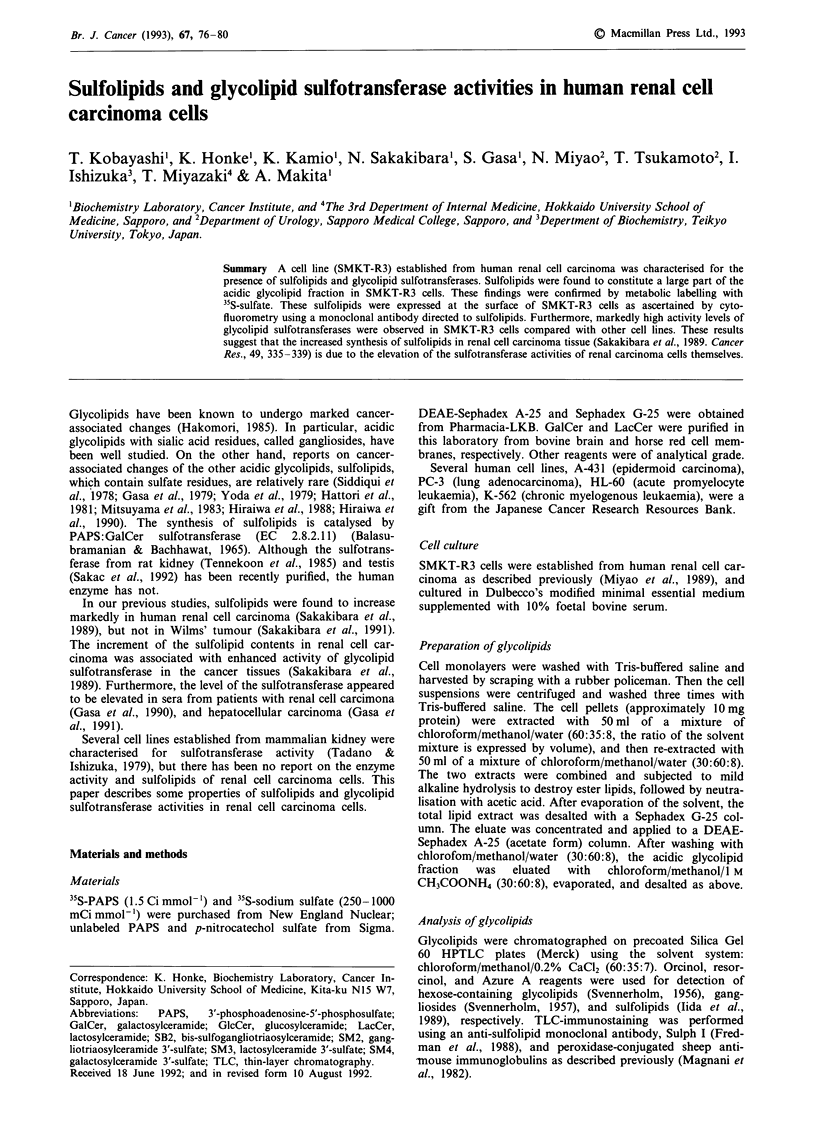
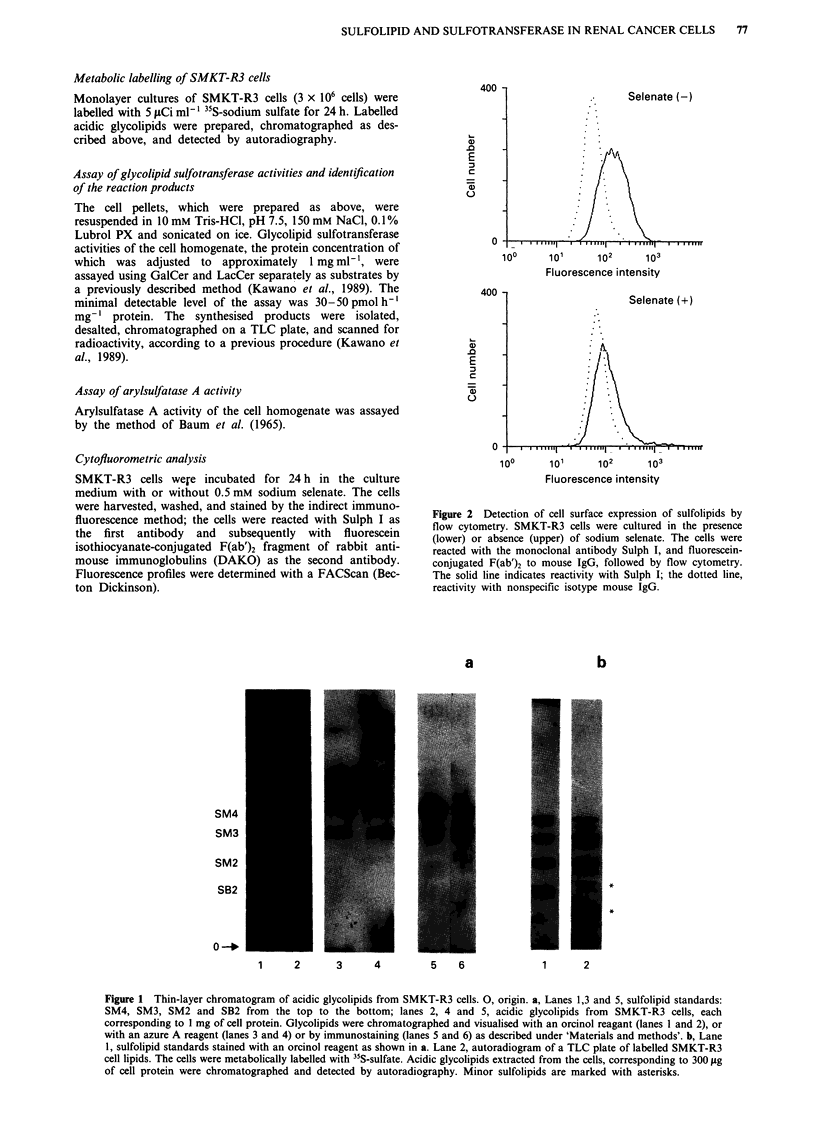
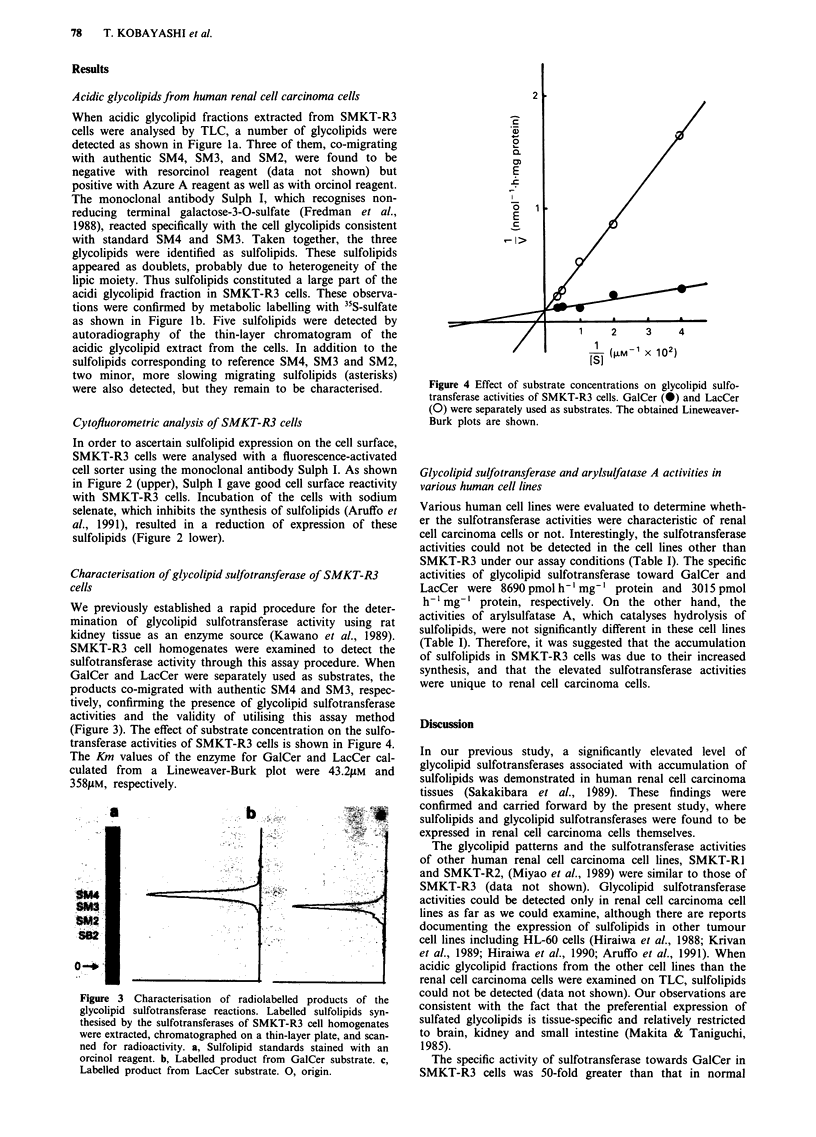
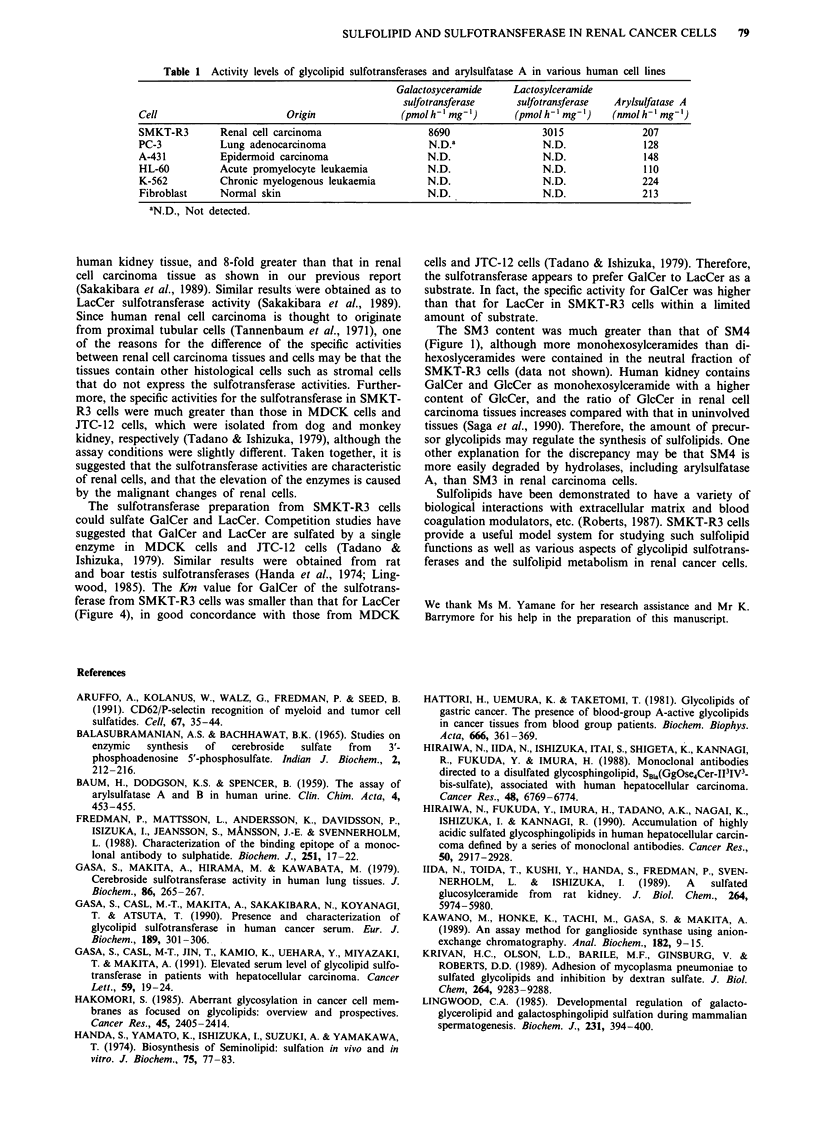
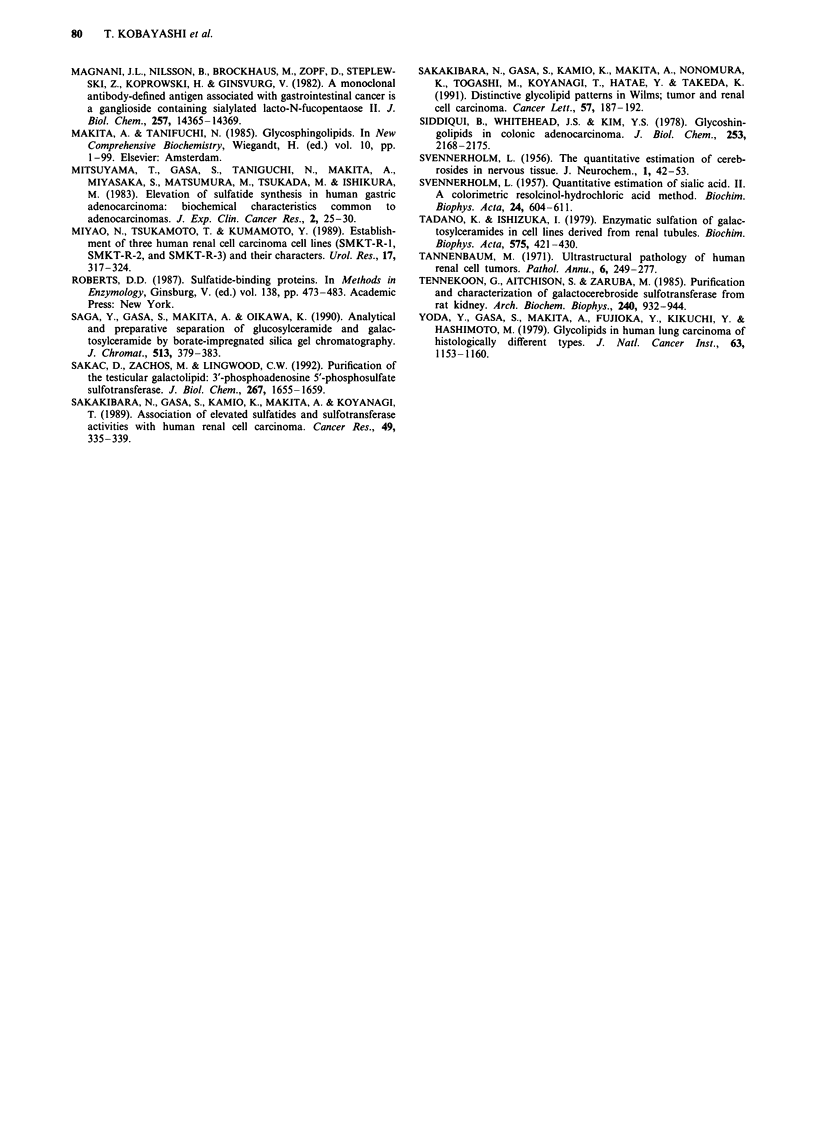
Images in this article
Selected References
These references are in PubMed. This may not be the complete list of references from this article.
- Aruffo A., Kolanus W., Walz G., Fredman P., Seed B. CD62/P-selectin recognition of myeloid and tumor cell sulfatides. Cell. 1991 Oct 4;67(1):35–44. doi: 10.1016/0092-8674(91)90570-o. [DOI] [PubMed] [Google Scholar]
- BAUM H., DODGSON K. S., SPENCER B. The assay of arylsulphatases A and B in human urine. Clin Chim Acta. 1959 May;4(3):453–455. doi: 10.1016/0009-8981(59)90119-6. [DOI] [PubMed] [Google Scholar]
- Balasubramanian A. S., Bachhawat B. K. Studies on enzymic synthesis of cerebroside sulphate from 3'-phosphoadenosine-5'-phosphosulphate. Indian J Biochem. 1965 Dec;2(4):212–216. [PubMed] [Google Scholar]
- Fredman P., Mattsson L., Andersson K., Davidsson P., Ishizuka I., Jeansson S., Månsson J. E., Svennerholm L. Characterization of the binding epitope of a monoclonal antibody to sulphatide. Biochem J. 1988 Apr 1;251(1):17–22. doi: 10.1042/bj2510017. [DOI] [PMC free article] [PubMed] [Google Scholar]
- Gasa S., Casl M. T., Jin T., Kamio K., Uehara Y., Miyazaki T., Makita A. Elevated serum level of glycolipid sulfotransferase in patients with hepatocellular carcinoma. Cancer Lett. 1991 Jul 26;59(1):19–24. doi: 10.1016/0304-3835(91)90130-a. [DOI] [PubMed] [Google Scholar]
- Gasa S., Casl M. T., Makita A., Sakakibara N., Koyanagi T., Atsuta T. Presence and characterization of glycolipid sulfotransferase in human cancer serum. Eur J Biochem. 1990 Apr 30;189(2):301–306. doi: 10.1111/j.1432-1033.1990.tb15490.x. [DOI] [PubMed] [Google Scholar]
- Gasa S., Makita A., Hirama M., Kawabata M. Cerebroside sulfotransferase activity in human lung tissues. An elevated level in lung adenocarcinoma. J Biochem. 1979 Jul;86(1):265–267. [PubMed] [Google Scholar]
- Hakomori S. Aberrant glycosylation in cancer cell membranes as focused on glycolipids: overview and perspectives. Cancer Res. 1985 Jun;45(6):2405–2414. [PubMed] [Google Scholar]
- Handa S., Yamato K., Ishizuka I., Suzuki A., Yamakawa T. Biosynthesis of seminolipid: sulfation in vivo and in vitro. J Biochem. 1974 Jan;75(1):77–83. doi: 10.1093/oxfordjournals.jbchem.a130385. [DOI] [PubMed] [Google Scholar]
- Hattori H., Uemura K., Taketomi T. The presence of blood group A-active glycolipids in cancer tissues from blood group O patients. Biochim Biophys Acta. 1981 Dec 23;666(3):361–369. doi: 10.1016/0005-2760(81)90295-2. [DOI] [PubMed] [Google Scholar]
- Hiraiwa N., Fukuda Y., Imura H., Tadano-Aritomi K., Nagai K., Ishizuka I., Kannagi R. Accumulation of highly acidic sulfated glycosphingolipids in human hepatocellular carcinoma defined by a series of monoclonal antibodies. Cancer Res. 1990 May 15;50(10):2917–2928. [PubMed] [Google Scholar]
- Hiraiwa N., Iida N., Ishizuka I., Itai S., Shigeta K., Kannagi R., Fukuda Y., Imura H. Monoclonal antibodies directed to a disulfated glycosphingolipid, SB1a (GgOse4Cer-II3IV3-bis-sulfate), associated with human hepatocellular carcinoma. Cancer Res. 1988 Dec 1;48(23):6769–6774. [PubMed] [Google Scholar]
- Iida N., Toida T., Kushi Y., Handa S., Fredman P., Svennerholm L., Ishizuka I. A sulfated glucosylceramide from rat kidney. J Biol Chem. 1989 Apr 5;264(10):5974–5980. [PubMed] [Google Scholar]
- Kawano M., Honke K., Tachi M., Gasa S., Makita A. An assay method for ganglioside synthase using anion-exchange chromatography. Anal Biochem. 1989 Oct;182(1):9–15. doi: 10.1016/0003-2697(89)90709-4. [DOI] [PubMed] [Google Scholar]
- Krivan H. C., Olson L. D., Barile M. F., Ginsburg V., Roberts D. D. Adhesion of Mycoplasma pneumoniae to sulfated glycolipids and inhibition by dextran sulfate. J Biol Chem. 1989 Jun 5;264(16):9283–9288. [PubMed] [Google Scholar]
- Lingwood C. A. Developmental regulation of galactoglycerolipid and galactosphingolipid sulphation during mammalian spermatogenesis. Evidence for a substrate-selective inhibitor of testicular sulphotransferase activity in the rat. Biochem J. 1985 Oct 15;231(2):393–400. doi: 10.1042/bj2310393. [DOI] [PMC free article] [PubMed] [Google Scholar]
- Magnani J. L., Nilsson B., Brockhaus M., Zopf D., Steplewski Z., Koprowski H., Ginsburg V. A monoclonal antibody-defined antigen associated with gastrointestinal cancer is a ganglioside containing sialylated lacto-N-fucopentaose II. J Biol Chem. 1982 Dec 10;257(23):14365–14369. [PubMed] [Google Scholar]
- Miyao N., Tsukamoto T., Kumamoto Y. Establishment of three human renal cell carcinoma cell lines (SMKT-R-1, SMKT-R-2, and SMKT-R-3) and their characters. Urol Res. 1989;17(5):317–324. doi: 10.1007/BF00262990. [DOI] [PubMed] [Google Scholar]
- Roberts D. D. Sulfatide-binding proteins. Methods Enzymol. 1987;138:473–483. doi: 10.1016/0076-6879(87)38040-1. [DOI] [PubMed] [Google Scholar]
- SVENNERHOLM L. Quantitative estimation of sialic acids. II. A colorimetric resorcinol-hydrochloric acid method. Biochim Biophys Acta. 1957 Jun;24(3):604–611. doi: 10.1016/0006-3002(57)90254-8. [DOI] [PubMed] [Google Scholar]
- SVENNERHOLM L. The quantitative estimation of cerebrosides in nervous tissue. J Neurochem. 1956 May;1(1):42–53. doi: 10.1111/j.1471-4159.1956.tb12053.x. [DOI] [PubMed] [Google Scholar]
- Sakac D., Zachos M., Lingwood C. A. Purification of the testicular galactolipid: 3'-phosphoadenosine 5'-phosphosulfate sulfotransferase. J Biol Chem. 1992 Jan 25;267(3):1655–1659. [PubMed] [Google Scholar]
- Sakakibara N., Gasa S., Kamio K., Makita A., Koyanagi T. Association of elevated sulfatides and sulfotransferase activities with human renal cell carcinoma. Cancer Res. 1989 Jan 15;49(2):335–339. [PubMed] [Google Scholar]
- Sakakibara N., Gasa S., Kamio K., Makita A., Nonomura K., Togashi M., Koyanagi T., Hatae Y., Takeda K. Distinctive glycolipid patterns in Wilms' tumor and renal cell carcinoma. Cancer Lett. 1991 May 24;57(3):187–192. doi: 10.1016/0304-3835(91)90155-b. [DOI] [PubMed] [Google Scholar]
- Siddiqui B., Whitehead J. S., Kim Y. S. Glycosphingolipids in human colonic adenocarcinoma. J Biol Chem. 1978 Apr 10;253(7):2168–2175. [PubMed] [Google Scholar]
- Tadano K., Ishizuka I. Enzymatic sulfation of galactosyl- and lactosylceramides in cell lines derived from renal tubules. Biochim Biophys Acta. 1979 Dec 18;575(3):421–430. [PubMed] [Google Scholar]
- Tannenbaum M. Ultrastructural pathology of human renal cell tumors. Pathol Annu. 1971;6:249–277. [PubMed] [Google Scholar]
- Tennekoon G., Aitchison S., Zaruba M. Purification and characterization of galactocerebroside sulfotransferase from rat kidney. Arch Biochem Biophys. 1985 Aug 1;240(2):932–944. doi: 10.1016/0003-9861(85)90102-x. [DOI] [PubMed] [Google Scholar]
- Yoda Y., Gasa S., Makita A., Fujioka Y., Kikuchi Y., Hashimoto M. Glycolipids in human lung carcinoma of histologically different types. J Natl Cancer Inst. 1979 Nov;63(5):1153–1160. [PubMed] [Google Scholar]




